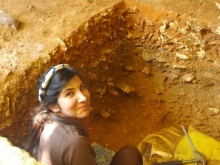
Bio
Aylar Abdolahzadeh is a Ph.D. candidate in Paleolithic archaeology and Junior Fellow of the Louis J. Kolb Society. She investigates variability in the frequency of fire use in the archaeological record of the Late Pleistocene of Europe and the Near East. In her dissertation, she analysed burned lithics as a proxy for the frequency of fire use to understand the nature and the degree of fire use in the geographic contexts and climatic conditions of the Late Pleistocene. In addition, experimental lithic studies have been a major part of her graduate training at the archaeology lab at the Penn Museum. Currently conducting heat-fracturing and frost-fracturing experiments, she is interested in measuring the taphonomic impacts of fire and frost-weathering on archaeological lithics assemblages. You can find some of our experimental work on ResearchGate: https://www.researchgate.net/profile/Aylar_Abdolahzadeh
Education
M.A. University of Tarbiat Modares, Tehran, Iran. 2010. Major: Archaeology, Minor: Prehistoric Archaeology.
B.A. University of Tehran, Tehran, Iran. 2007. Major: Archaeology, Minor: Humanities.
Research Interests
My research interest is to work on identifying specific transition patterns between Middle and Upper Paleolithic sequences (in situ evolution of the Upper Palaeolithic from the local Mousterian) in Western Asia. I plan to use lithic industries, which are the best-preserved remains of the past, to understand how the transition occurred and developed. I would like to know whether the technological variability between the Early Upper Paleolithic can be related to different environmental conditions. If so, how can we determine these interactions through observation of variation in stone tools? Can these different technological identities consequently play an important role in understanding of human modern dispersal in Western Eurasia?

 Department of Anthropology
Department of Anthropology